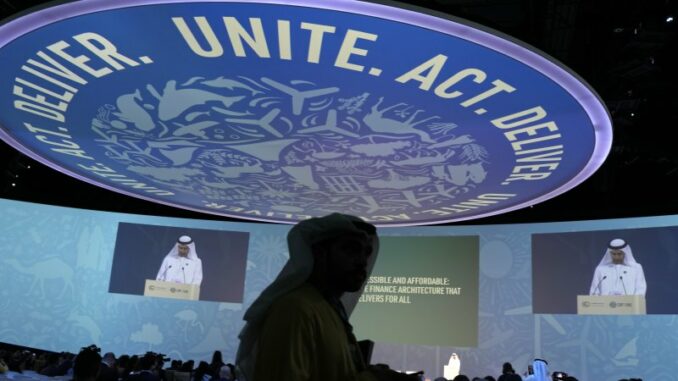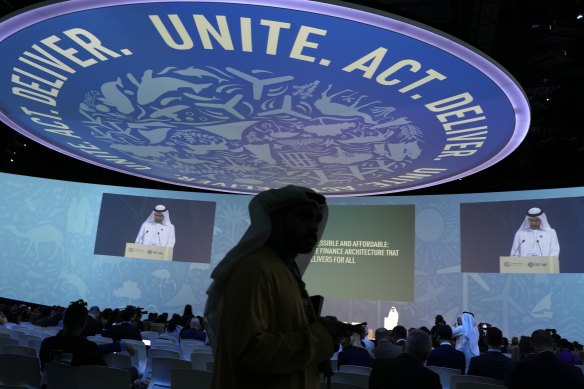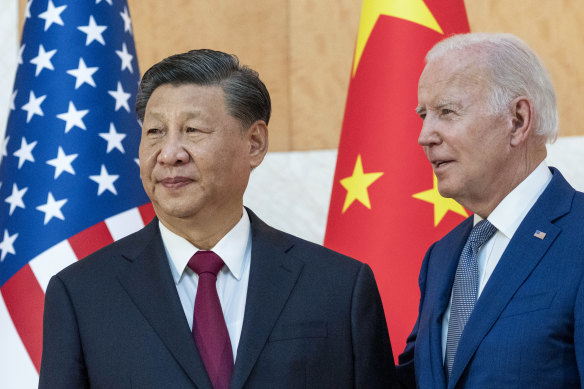
Save articles for later
Add articles to your saved list and come back to them any time.
Whether the world cuts carbon emissions fast enough to secure a 1.5-degree planet depends on the arms race for clean-tech dominance between the US and China.
It does not depend significantly on anything done, and even less said, at the COP28 summit in Dubai, a process that risks becoming a net negative for progress, if it has not already crossed that line as a full army corps of lobbyists converge with 97,000 others at petroleum ground zero.
Cop28 kicked off last week in Dubai. Credit: AP
The annual COP gathering is itself a fossilised racket, an anachronistic showdown between the West and a victim category of “developing countries” that is frozen in time and contains some of the richest and most brazen polluters, or others that still build coal plants and persecute ecologists.
The environmental press corps will anguish over whether the text progresses from a “phase-down” to a “phase-out” of coal power plants, and whether petrostates lift their veto on such language for oil and gas. Passions will fly over a get-out clause for “abated” fossil fuels, and whether carbon capture really counts.
The language matters, and the precise wording can be mobilised for climate lawfare in civil courts, at least in rule of law states. But technology and geo-economic reality are already moving faster than the COP curriculum can keep up.
“A global, irreversible, solar tipping point may have passed where solar energy gradually comes to dominate global electricity markets, without any further climate policies,” concluded a recent paper by the World Bank and Europe’s leading universities.
The “technological learning rate” of solar, wind, and now batteries is so relentless that a 24/7 mix is already cheaper than new coal in most of the world, and will become massively cheaper almost everywhere over time.
The report said the priority now is to sort out the details, upgrade grids, and channel the necessary funds to Africa. It is also a ferocious indictment of the “energy modelling community” that failed to see this coming.
China is rolling out 210 gigawatts (GW) of solar this year, not far short of the entire installation worldwide the year before. Carbon Brief says it is expanding its solar panel capacity to 1000GW by 2025, and increasing its battery capacity six fold.
The race for clean-tech dominance between the US and China will help the world achieve its climate goals.Credit: AP
This is not the result of altruism. It is happening because China a) wants a cheap and secure source of home-grown power beyond American naval reach, b) has acquired manufacturing dominance of renewables and wishes to leverage the advantage, and c) aims to dethrone the West’s auto industry.
America is responding with $US2 trillion ($3.1 trillion) of manufacturing rearmament because it a) cannot let this happen, b) still leads in applied sciences, and can win the fight, and c) recognises that clean tech is the economic prize of our time.
Europe is responding because its industries will be obliterated if it does not. None of this has much to do with the COP process.
“The transition to clean energy is happening worldwide and it’s unstoppable. It’s not a question of ‘if’, it’s just a matter of ‘how soon’,” said Fatih Birol, head of the International Energy Agency.
The pace depends on whether vested interests succeed in delaying the rollout of technology that already exists, and whether they can head off investment in new technology at the point of critical breakthrough.
Electric vehicles are already there. Decent EVs retail today in the Chinese mass market for $US10,000-$US15,000 without purchase subsidies. Credible analysts in China think EVs will surpass 50 per cent of sales within two years.
Europe will catch up as cheaper models flood showrooms circa 2025, albeit nearer $US20,000-$US25,000. This is before the arrival of solid-state batteries and other variants that should triple range before the end of the decade, without the need for cobalt.
The US Energy Department is targeting green hydrogen at $US1 a kilo by 2030. Anything from $US1.50-$US2 opens the way for a displacement of fossils in dirty hydrogen, and then for fertilisers, steel, shipping, etc, going down the Liebreich “hydrogen ladder”, covering some 20 per cent of emissions.
Cell-grown chicken and lab-fermented milk is on the market today in the US, the first of a wave of bioidentical meats and dairy likely to undercut Big Meat on cost within five years, disrupting the industrial-scale market for sausages, burgers, nuggets, and so forth, with a fraction of the water needs and CO2 emissions.
Whatever language comes out of Cop28, it will not inconvenience coal, gas and oil interests in any serious way.
This will alleviate the strain on croplands used for animal feed. It may enable some reforestation and surplus biofuel for jet travel.
More exotically, nuclear fusion at competitive cost may not be as far away as people think. The Fusion Industry Association says 65 per cent of its members think commercial fusion power – at viable cost, and the radioactive waste of a hospital – could be a reality by 2035, and 90 per cent by 2040. They are eyeing costs of $US60-$US80MWh. That would seal the argument.
The COP process was necessary to kickstart clean technology and bring it to scale. The Paris Agreement in 2015 sent the message that the game was up for the carbon economy. It was the moment when Big Money grew wary of fossil finance. It defected to the other side, discerning larger fortunes to be made in the new industries.
This pulled forward investment and brought us to where we are today.
The baton has by now passed. With each year the COP process is more clearly becoming a venue for vested interests – Big Oil, Industrial Meat, Old Auto, you name it – trying to slow down the post-carbon juggernaut.
Sultan Al-Jaber has proved a capable president of COP28, earning plaudits even from some green activists. He is right that you need “smart decarbonisation” and political “buy-in” from fossil producers and users. What are we going to do about the 2,000 coal-fired plants in Asia built mostly between 2005 and 2018 with a lifespan of 40-45 years that must keep burning to pay off project debt?
But he also presides over Abu Dhabi’s national oil company, which is expanding crude output from three million to five million barrels a day over the next seven years, with emissions to match, and “no credible plan whatsoever to reduce them”, in the words of climateer Al Gore.
Al-Jaber said two weeks ago that there was “no science out there, or no scenario out there, that says that the phaseout of fossil fuel is what’s going to achieve 1.5”.
He is right. We will still need some oil and gas in 2050. The CO2 will be offset by removal technologies, or captured and sequestered.
But Gore is also right that fossil interests are promoting “falsehoods on an industrial scale”, intervening at every level across the world, “with their lobbyists and with their fixers, doing everything they can to slow down progress”, and have “brazenly seized control of the COP process”.
Whatever language comes out of COP28, it will not inconvenience coal, gas and oil interests in any serious way.
Like all large synods that grow too big, lose focus and fall prey to carpetbaggers, the COP process has outlived its original purpose.
It is a jarring mix of climate doomerism and delaying-tactics. It should stick to scientific reports and to helping vulnerable nations at the sharp end of climate change.
Technology and market price signals are already solving the problem without need for degrowth, hairshirts and sacrifice. That is what we should be proclaiming from the rooftops.
Telegraph, London
The Business Briefing newsletter delivers major stories, exclusive coverage and expert opinion. Sign up to get it every weekday morning.
Most Viewed in Business
From our partners
Source: Read Full Article

